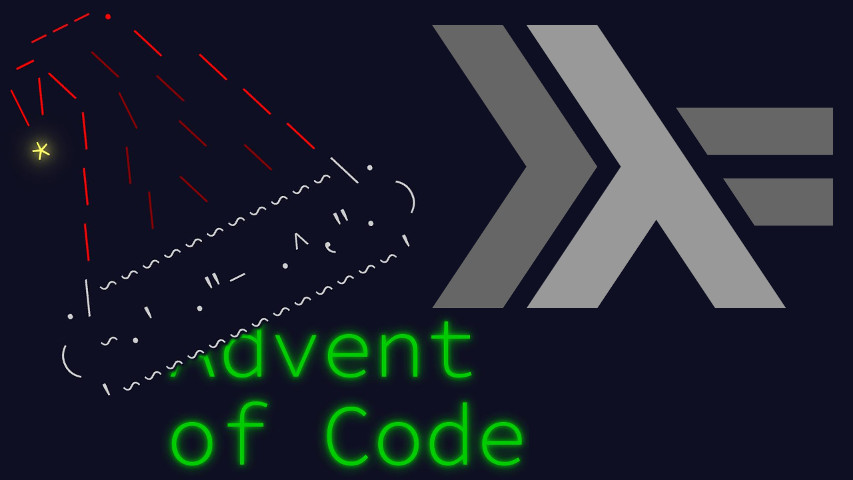Let’s do some 2D array manipulation for today’s Advent of Code!
This post is literate Haskell. I’ve tried to keep the import list short, but I’ll still need a few things.
import Data.Array (Array,(!),bounds,inRange,indices,listArray)
import Data.Array.ST (newArray,runSTArray,writeArray)
import Data.Char (digitToInt)
import Data.Function (fix)
import Control.Monad (forM_,when)
import Linear.V2 (V2(V2))We’ll be manipulating 2D coordinates in arrays all the time, so let’s try and use a sensible type for that.
type V = V2 IntLet’s assume we’ve already parsed the input to a 2D array of tree
heights represented as Ints. In part 1, we’d like to know
which trees in the grid are visible from the outside, which we’ll
represent as a Bool.
part1 :: Array V Int -> Array V BoolA tree is visible from a side if it is the tallest in the line of trees from itself to that side. This can be nicely computed in linear time by taking it the other way: start from a side and dive in; for each tree encountered while going across, mark it as visible if it’s taller than the tallest tree to that point, then update the height of the tallest tree yet seen in this line.
We’ll start with a tallest seen tree of − 1 to make sure the tree at the edge is visible no matter what.
We accept a tree as visible if it is visible from any side, so we’ll
start with an initial visibility map of False and
unconditionally mark as True when we discover new visible
trees.
It’s still unnatural imperative style code, but sometimes it has to be done. Start by allocating the result array.
part1 g = runSTArray $ do
result <- newArray (bounds g) FalseDefine a function to perform all visibility checks from a given side.
Represent said side as a list of starting points, the edge,
and a direction.
let beam edge dir =Iterate on the starting points.
forM_ edge $ \p0 ->Remember the tallest height seen to date, starting at − 1, and iterate.
flip fix (p0,(-1)) $ \loop (p,h) ->Test we’re still in range.
when (inRange (bounds g) p) $ doDetermine visibility by comparing to current tallest known height.
when (g!p > h) $ writeArray result p TrueRecurse, updating next considered tree position and new tallest known height.
loop (p + dir,max h (g!p))With that handy function, all we have to do is call it four times, once per side, with the appropriate fringe and direction.
let (V2 t l,V2 b r) = bounds g
beam [V2 t j | j <- [l..r]] (V2 1 0)
beam [V2 b j | j <- [l..r]] (V2 (-1) 0)
beam [V2 i l | i <- [t..b]] (V2 0 1)
beam [V2 i r | i <- [t..b]] (V2 0 (-1))
pure resultCounting Trues would then basically yield the AoC
checksum.
For part 2, we consider visibility from within the grid. There’s a fancy way to compute it in linear time, but it requires getting out the DP, and the AoC input is so small it’s really not worth it. Maybe later this year!
Instead we’ll simply do exactly what it says and shoot rays out from every single tree in the grid, counting how far until sight is obstructed. Quadratic but simple.
And no imperative bullshit this time: we can return the array values directly:
part2 :: Array V Int -> Array V Int
part2 g = listArray (bounds g) (scenicScore <$> indices g)The scenic score is defined as the product of the viewing distances in the 4 directions.
where
scenicScore p =
product $ viewingDistance p <$> [V2 1 0,V2 (-1) 0,V2 0 1,V2 0 (-1)]The viewing distance is the distance to the first tree as tall or taller as the starting point.
viewingDistance p dir =
length $ takeWhile' (< g!p) $ map (g!) $ rayFromDir' p dirA first helper function yields valid tree indices in a line from a given starting point.
rayFromDir' p d = tail $ takeWhile (inRange (bounds g)) $ iterate (+d) pA second helper will behave like standard Prelude function
takeWhile, but additionally returning the first list
element that fails the test.
takeWhile' :: (a -> Bool) -> [a] -> [a]
takeWhile' f = go where
go [] = []
go (x:xs) = x : if f x then go xs else []And we’re done!
Well, almost. Just a little wrapper to parse the input and compute the output:
main :: IO ()
main = do
raw <- lines <$> getContents
let w = length (head raw)
h = length raw
grid = listArray (0,V2 (h-1) (w-1)) (digitToInt <$> concat raw)
print $ sum $ fmap fromEnum $ part1 grid
print $ maximum $ part2 gridThis concludes today’s puzzle. See you tomorrow!



